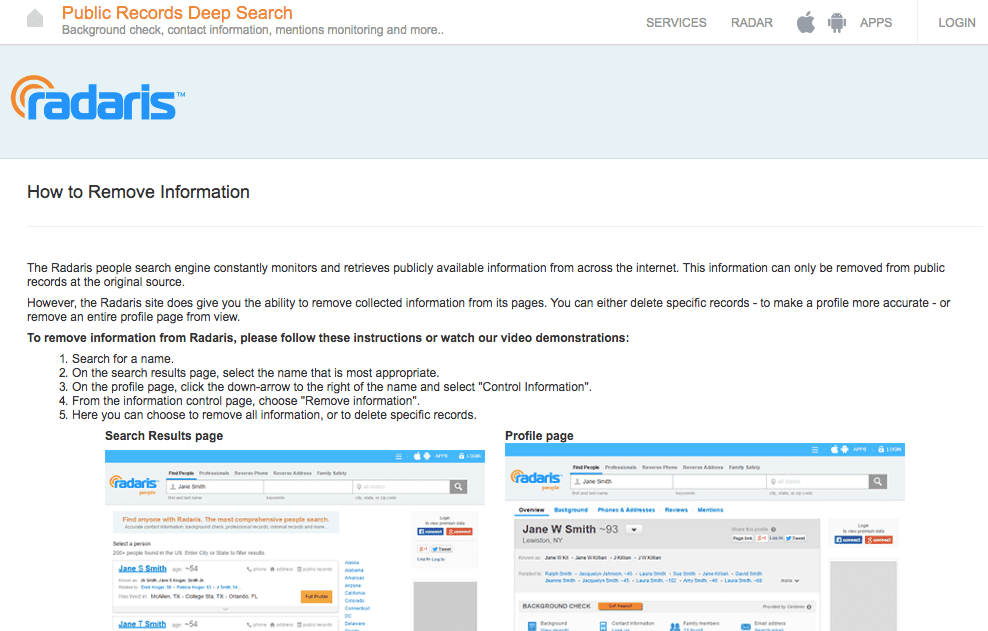How To Remove Your Personal Information From The Internet

Table of Contents
Identifying Your Online Presence
Before you can remove your personal information from the internet, you need to know where it's located. This involves a thorough search across various online platforms.
Finding Your Personal Information
Use a multi-pronged approach to uncover your digital footprint. This includes leveraging search engines and exploring less obvious corners of the web.
-
Use advanced search operators: Google, DuckDuckGo, and other search engines offer powerful tools. Use advanced search operators like
"site:example.com" your name,"your name" inurl:contact, or"your email address"to narrow your search and find specific instances of your information. -
Check social media profiles: Review your profiles on Facebook, Twitter, Instagram, LinkedIn, and other platforms. Look for any personal information that you'd prefer to remove, including photos, contact details, and past posts. Consider adjusting your privacy settings to limit visibility.
-
Explore image search: Use Google Images or other image search engines to see if any photos of you are publicly available online. This is particularly important if you have unique identifying features.
-
Search forums and blogs: Check popular online forums and blogs relevant to your interests or profession. Your name or email address might appear in comments or posts.
Thoroughly searching for your personal data is essential. Don't underestimate the power of combining different search methods to uncover all instances of your information online.
Removing Information From Search Engines
Once you've identified your online presence, you can start removing information from search engine results. However, it's crucial to understand the limitations of this process. Removing information from search results doesn't remove the information from its source; it simply makes it less easily accessible through search engines.
Understanding Google's Removal Process
Google provides a process for requesting the removal of certain types of information from its search results. This typically includes outdated contact information, doxxing, or other sensitive information. However, this process doesn't guarantee removal and is not always successful.
-
Submitting a removal request: Google's removal request process involves submitting a form, providing documentation, and clearly explaining why the information should be removed. Be prepared to wait for a response, which may take some time.
-
Understanding Google's response times: Google typically responds within a few weeks, but it can take longer depending on the complexity of the request. Not all requests are granted. Understand that Google prioritizes the right to access information.
-
Limitations: Google's removal process mainly affects search results, not the source material. The information might still be available elsewhere on the internet.
Using Google's Removal Tools
Google offers several tools to help individuals remove their personal information from its search results. Familiarize yourself with these tools and follow the instructions carefully.
-
Google's removal request form: This form requires you to provide details about the information you want removed and reasons for removal. Clear, concise communication is crucial.
-
Necessary documentation: Depending on your request, you might need to provide supporting documents such as identification and proof of ownership. Keep records of all communications with Google.
Successful removal requests often involve clear and convincing arguments for removal, along with adequate documentation. Understanding why Google may reject a request is important for resubmission.
Removing Information From Websites and Platforms
Removing information directly from websites and platforms often requires more proactive engagement.
Contacting Website Owners
Directly contacting website owners is a crucial step in removing your personal information.
-
Contact methods: Use available contact methods like email, contact forms, or phone numbers. Be polite but firm in your request.
-
Sample email templates: Use clear and concise language, identifying yourself and specifying the information you want removed. For example: "Subject: Removal Request - [Your Name] - [URL of page with information]". The body should clearly state your request and provide any relevant identification.
Persistence is key. Keep records of all communications and follow up if you don't receive a response.
Utilizing Data Subject Access Requests (DSAR)
Data Subject Access Requests (DSARs) are legal requests to access and potentially remove your personal data held by companies. This is particularly useful for larger organizations that may not have readily available contact methods for data removal.
-
Initiating a DSAR: Follow the instructions provided by the organization on their website. This typically involves filling out a form and providing proof of identity.
-
Information you can request: A DSAR can help you access and potentially request the deletion of a wide range of information, including contact details, financial information, and browsing history.
-
Response times: Organizations typically have a set timeframe to respond to a DSAR. This varies by jurisdiction and organization.
Understanding your data rights is crucial in ensuring effective removal. A DSAR empowers you to manage your data within legal frameworks.
Deleting Social Media Accounts and Posts
Social media platforms offer tools to delete accounts and individual posts. However, the process varies across different platforms.
-
Step-by-step instructions: Each platform (Facebook, Twitter, Instagram, etc.) has its own method for deleting accounts and posts. Consult the platform's help center for detailed instructions.
-
Platform differences: Carefully review the settings before deletion. Understand the implications of deleting an account and how this might affect associated services.
Thoroughly reviewing your settings before deletion ensures you understand the consequences and can minimize unintended data loss.
Protecting Yourself From Future Exposure
Preventing future exposure of your personal information requires proactive measures.
Best Practices for Online Privacy
Implementing strong online privacy practices minimizes the risk of future data breaches.
-
Strong passwords: Use unique, strong passwords for all your online accounts. Consider using a password manager.
-
Two-factor authentication (2FA): Enable 2FA whenever possible. This adds an extra layer of security.
-
Mindful sharing: Be cautious about the information you share online. Think twice before posting sensitive data on social media or forums.
-
Privacy-focused tools: Use privacy-focused browsers and browser extensions that block trackers and enhance your online privacy.
Regularly updating passwords, avoiding public Wi-Fi for sensitive transactions, and being wary of phishing scams are crucial steps in securing your online presence.
Conclusion
Removing your personal information from the internet is a multi-step process requiring persistence and attention to detail. By following the steps outlined in this guide – identifying your online presence, removing information from search engines and websites, and proactively protecting yourself from future exposure – you can significantly improve your online privacy and security. Don't wait until it's too late! Start removing your personal information from the internet today to protect your privacy and security. Use the steps outlined above to regain control of your online presence and effectively manage your digital footprint, thus removing personal data online and deleting personal information from the web. Remember that protecting your online privacy is an ongoing process requiring vigilance and proactive measures.

Featured Posts
-
 Ankara Da 10 Mart 2025 Pazartesi Iftar Ve Sahur Vakitleri
Apr 23, 2025
Ankara Da 10 Mart 2025 Pazartesi Iftar Ve Sahur Vakitleri
Apr 23, 2025 -
 Arizona Diamondbacks Beat Milwaukee Brewers 5 2
Apr 23, 2025
Arizona Diamondbacks Beat Milwaukee Brewers 5 2
Apr 23, 2025 -
 2025 Us Holiday Calendar A Comprehensive Guide To Federal And Non Federal Holidays
Apr 23, 2025
2025 Us Holiday Calendar A Comprehensive Guide To Federal And Non Federal Holidays
Apr 23, 2025 -
 Pazartesi Guenue Okullar Tatil Mi Istanbul Da Son Dakika Haberleri
Apr 23, 2025
Pazartesi Guenue Okullar Tatil Mi Istanbul Da Son Dakika Haberleri
Apr 23, 2025 -
 Bof A Says Dont Worry About Stretched Stock Market Valuations
Apr 23, 2025
Bof A Says Dont Worry About Stretched Stock Market Valuations
Apr 23, 2025
